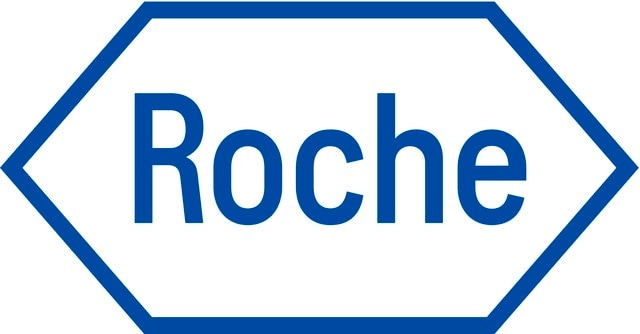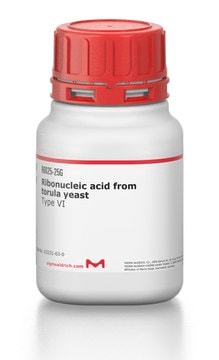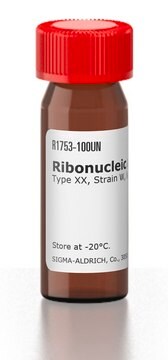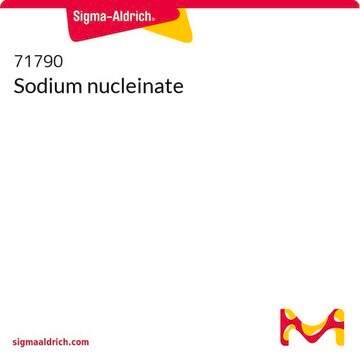R6750
Ribonucleic acid from baker′s yeast (S. cerevisiae)
Synonyme(s) :
RNA
Se connecterpour consulter vos tarifs contractuels et ceux de votre entreprise/organisme
About This Item
Produits recommandés
Niveau de qualité
Température de stockage
−20°C
Vous recherchez des produits similaires ? Visite Guide de comparaison des produits
Catégories apparentées
Description générale
Ribonucleic Acid (RNA) from baker’s yeast (S. cerevisiae) is the substrate for RNase enzyme. The isolation of RNA from yeast is a complicated process and involves heating and freezing cycles of cells in the presence of phenyl and detergents (SDS).
Application
Ribonucleic Acid (RNA) from baker’s yeast (S. cerevisiae) is suitable for applications such as northern blot hybridization, reverse transcriptase-polymerase chain reaction (RTPCR), and cDNA construction.
Notes préparatoires
Prepared by a modification of Crestfield, A.M., et al., J. Biol. Chem., 216, 185 (1955).
Code de la classe de stockage
11 - Combustible Solids
Classe de danger pour l'eau (WGK)
WGK 3
Point d'éclair (°F)
Not applicable
Point d'éclair (°C)
Not applicable
Équipement de protection individuelle
Eyeshields, Gloves, type N95 (US)
Faites votre choix parmi les versions les plus récentes :
Déjà en possession de ce produit ?
Retrouvez la documentation relative aux produits que vous avez récemment achetés dans la Bibliothèque de documents.
Les clients ont également consulté
Lukas Bossaller et al.
Journal of immunology (Baltimore, Md. : 1950), 197(4), 1044-1053 (2016-06-30)
Systemic lupus erythematosus (SLE) is a chronic, life-threatening autoimmune disorder, leading to multiple organ pathologies and kidney destruction. Analyses of numerous murine models of spontaneous SLE have revealed a critical role for endosomal TLRs in the production of autoantibodies and
Hidekazu Iioka et al.
Nucleic acids research, 39(8), e53-e53 (2011-02-09)
The diverse localization of transcripts in cells suggests that there are many specific RNA-protein interactions that have yet to be identified. Progress has been limited, however, by the lack of a robust method to detect and isolate the RNA-binding proteins.
Michael R Green et al.
Cold Spring Harbor protocols, 2021(12) (2021-12-03)
Isolation of RNA from yeast is complicated by the need to first break the thick, rigid cell wall. The protocol provided here uses a cycle of heating and freezing of cells in the presence of phenol and the detergent sodium
Stephanie C Bannister et al.
Biology of reproduction, 81(1), 165-176 (2009-04-10)
MicroRNAs are a highly conserved class of small RNAs that function in a sequence-specific manner to posttranscriptionally regulate gene expression. Tissue-specific miRNA expression studies have discovered numerous functions for miRNAs in various aspects of embryogenesis, but a role for miRNAs
Hilal Kazan et al.
Nucleic acids research, 41(Web Server issue), W180-W186 (2013-06-12)
RBPmotif web server (http://www.rnamotif.org) implements tools to identify binding preferences of RNA-binding proteins (RBPs). Given a set of sequences that are known to be bound and unbound by the RBP of interest, RBPmotif provides two types of analysis: (i) de
Protocoles
This procedure may be used for determination of Ribonuclease A (RNase A) activity.
Notre équipe de scientifiques dispose d'une expérience dans tous les secteurs de la recherche, notamment en sciences de la vie, science des matériaux, synthèse chimique, chromatographie, analyse et dans de nombreux autres domaines..
Contacter notre Service technique










